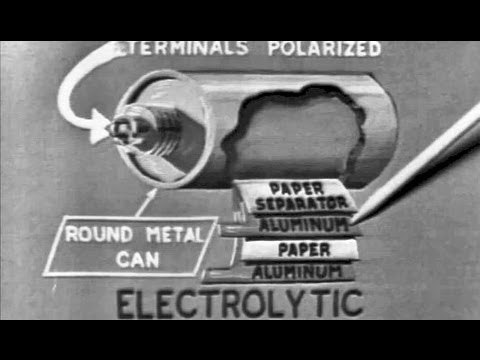more at
“DEFINES ELECTROSTATIC FIELD AND DIELECTRIC. DESCRIBES AIR, PAPER, OIL, ELECTROLYTIC, AND CERAMIC TYPE CAPACITORS AS TO THEIR CONSTRUCTION AND GENERAL USAGE. THE UNIT FOR MEASURING CAPACITORS, THE “FARAD”, IS STATED AND EXAMPLES OF COMPUTING CAPACITANCE ARE GIVEN. THE FACTORS OF DIELECTRIC, PLATE AREA, AND DISTANCE BETWEEN PLATES WHICH AFFECT THE VALUE OF CAPACITANCE ARE PRESENTED, AND THE NARRATOR DISCUSSES THEIR EFFECTS ON CAPACITANCE. DEFINES VOLTAGE RATING AND EXPLAINS THE FACTORS WHICH AFFECT THE VOLTAGE RATINGS OF CAPACITORS.”
United States Air Force Training Film TV-209
NEW VERSION with improved video & sound:
Public domain film from the National Archives, slightly cropped to remove uneven edges, with the aspect ratio corrected, and mild video noise reduction applied.
The soundtrack was also processed with volume normalization, noise reduction, clipping reduction, and/or equalization (the resulting sound, though not perfect, is far less noisy than the original).
ELECTRONICS PLAYLIST:
A capacitor (originally known as condenser) is a passive two-terminal electrical component used to store energy in an electric field. The forms of practical capacitors vary widely, but all contain at least two electrical conductors separated by a dielectric (insulator); for example, one common construction consists of metal foils separated by a thin layer of insulating film. Capacitors are widely used as parts of electrical circuits in many common electrical devices.
When there is a potential difference (voltage) across the conductors, a static electric field develops across the dielectric, causing positive charge to collect on one plate and negative charge on the other plate. Energy is stored in the electrostatic field. An ideal capacitor is characterized by a single constant value, capacitance, measured in farads. This is the ratio of the electric charge on each conductor to the potential difference between them.
The capacitance is greatest when there is a narrow separation between large areas of conductor, hence capacitor conductors are often called “plates,” referring to an early means of construction. In practice, the dielectric between the plates passes a small amount of leakage current and also has an electric field strength limit, resulting in a breakdown voltage, while the conductors and leads introduce an undesired inductance and resistance.
Capacitors are widely used in electronic circuits for blocking direct current while allowing alternating current to pass, in filter networks, for smoothing the output of power supplies, in the resonant circuits that tune radios to particular frequencies, in electric power transmission systems for stabilizing voltage and power flow, and for many other purposes…
In October 1745, Ewald Georg von Kleist of Pomerania in Germany found that charge could be stored by connecting a high-voltage electrostatic generator by a wire to a volume of water in a hand-held glass jar. Von Kleist’s hand and the water acted as conductors, and the jar as a dielectric (although details of the mechanism were incorrectly identified at the time). Von Kleist found, after removing the generator, that touching the wire resulted in a painful spark… The following year, the Dutch physicist Pieter van Musschenbroek invented a similar capacitor, which was named the Leyden jar, after the University of Leiden where he worked.
Daniel Gralath was the first to combine several jars in parallel into a “battery” to increase the charge storage capacity. Benjamin Franklin investigated the Leyden jar and “proved” that the charge was stored on the glass, not in the water as others had assumed. He also adopted the term “battery”, (denoting the increasing of power with a row of similar units as in a battery of cannon), subsequently applied to clusters of electrochemical cells. Leyden jars were later made by coating the inside and outside of jars with metal foil, leaving a space at the mouth to prevent arcing between the foils. The earliest unit of capacitance was the ‘jar’, equivalent to about 1 nanofarad.
Leyden jars or more powerful devices employing flat glass plates alternating with foil conductors were used exclusively up until about 1900, when the invention of wireless (radio) created a demand for standard capacitors, and the steady move to higher frequencies required capacitors with lower inductance. A more compact construction began to be used of a flexible dielectric sheet such as oiled paper sandwiched between sheets of metal foil, rolled or folded into a small package.
Early capacitors were also known as condensers, a term that is still occasionally used today. The term was first used for this purpose by Alessandro Volta in 1782…

